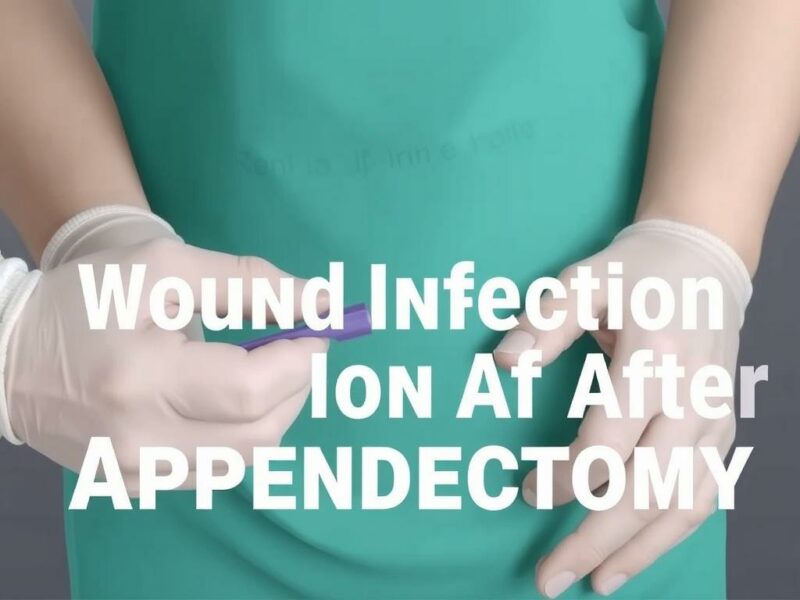What Is a Wound Infection After Appendectomy?
Undergoing an appendectomy, which is the surgical removal of the appendix, is a common and generally safe procedure. However, like all surgeries, it carries some risks, one of the most common being a wound infection after appendectomy. This type of infection occurs when bacteria invade the tissue at the site of the surgical incision, leading to redness, swelling, pain, and sometimes discharge. Recognizing and understanding the causes and symptoms of wound infection after appendectomy is essential to ensuring proper care and avoiding complications.
An appendectomy wound infection usually occurs within a few days to a week after the surgery, and the risk may increase depending on factors like the severity of the appendix inflammation, the patient’s overall health, and the hygiene maintained around the surgical site. While many people recover smoothly without any issues, it is critical to remain vigilant regarding signs like increased redness, fever, or unusual pain at the incision area, which could signal an infection.
Why Do Wound Infections Happen After Appendectomy?
The underlying causes of wound infection after appendectomy are usually related to bacteria entering the wound during or after surgery. The appendix is a part of the digestive system, and when inflamed or ruptured, it can release bacteria into the surrounding area. This increases the chance that bacteria may settle around the wound site, causing infection.
Other common factors contributing to wound infection after appendectomy include:
- Poor sterilization practices in the operating room.
- Inadequate wound care following surgery.
- Underlying medical conditions such as diabetes that impair healing.
- Obesity or smoking, which can negatively impact immune response.
- Delayed or improper use of antibiotics.
In specific cases, when the appendix has ruptured during surgery, surgeons may leave the wound open and pack it to allow drainage. Though necessary, this increases the risk of wound infection after appendectomy compared to a straightforward surgical removal.
Recognizing Symptoms of Wound Infection After Appendectomy
Knowing what signs to look for can help you catch a wound infection early. A wound infection after appendectomy typically presents with a variety of symptoms that signal your body is fighting bacteria. These may include:
- Redness and increased warmth around the surgical site.
- Pain or tenderness that worsens instead of improving day by day.
- Swelling or a raised area near the wound.
- Pus or cloudy fluid draining from the incision.
- Fever or chills indicating a systemic infection.
- Unpleasant odor from the wound area.
Paying attention to these symptoms and reporting them to your healthcare professional promptly can prevent the infection from worsening.
Types of Wound Infection After Appendectomy
Wound infections after appendectomy may vary in their nature and severity. Understanding these types helps patients and healthcare providers communicate effectively about treatment. Common types include:
| Type | Description | Typical Features |
|---|---|---|
| Superficial Incisional Infection | Affects only the skin and subcutaneous tissue of the incision. | Redness, tenderness, minor swelling, and pus discharge limited to skin. |
| Deep Incisional Infection | Involves deeper tissues beneath the skin. | Severe pain, swelling, fever, and may lead to abscess formation. |
| Organ/Space Infection | Occurs inside the abdominal cavity, such as an abscess near the site of appendectomy. | Persistent fever, abdominal pain, elevated white blood cell count post-surgery. |
Each infection type calls for different levels of treatment, so identifying the infection type helps provide the right care.
Risk Factors That Increase the Chances of Wound Infection After Appendectomy
Knowing your individual risks can empower you to take extra precautions. Several factors can increase the risk of wound infection after appendectomy, such as:
- Ruptured Appendix: Surgery after the appendix has burst exposes the abdomen to bacteria, raising infection risk.
- Poor Immune Function: Conditions like diabetes or immunosuppressive therapies can slow healing and increase infection risk.
- Obesity: Excess weight can reduce blood circulation, impairing wound healing and immune response.
- Age: Older adults may have delayed immune responses or healing.
- Smoking: Nicotine reduces blood flow, hampers healing, and increases infection risks.
- Lengthy or Complex Surgery: Prolonged surgical time may increase bacterial exposure.
Focusing on modifiable risks, such as quitting smoking or managing blood sugar, can lower your chances of wound infection after appendectomy.
How Are Wound Infections Diagnosed After Appendectomy?
Diagnosis of wound infection after appendectomy involves a careful physical examination combined with laboratory diagnostics. Doctors look for classic symptoms like redness, swelling, and discharge at the surgical site. Lab tests may include:
- Blood tests: Elevated white blood cell count typically indicates infection.
- Wound swab cultures: Identifying bacteria helps guide antibiotic treatment.
- Imaging studies: Ultrasound or CT scans might be used to detect abscesses or deeper infections.
Early diagnosis improves treatment outcomes, so don’t hesitate to share any concerns with your surgeon or primary care provider.
Treatment Options for Wound Infection After Appendectomy
Treating wound infection after appendectomy depends on the infection’s severity and type. Mild superficial infections may resolve with basic wound care and antibiotics. Deeper infections might require more intensive interventions. Common treatments include:
- Antibiotic Therapy: Oral or intravenous antibiotics target the specific bacteria responsible for infection.
- Wound Care: Regular cleaning, dressing changes, and sometimes drainage of pus if abscesses form.
- Surgical Intervention: In severe cases, reopening the wound or performing drainage procedures may be necessary.
- Supportive Care: Pain management, hydration, and monitoring vital signs to support recovery.
It’s vital to complete the full course of prescribed antibiotics and follow all wound care instructions to prevent recurring infections.
Preventing Wound Infection After Appendectomy
Prevention is always better than treatment. Fortunately, many wound infections after appendectomy are preventable with careful measures. Surgeons and patients can take several steps to reduce infection risks:
| Preoperative Measures | Postoperative Measures |
|---|---|
|
|
Communication between patients and healthcare providers about wound care and signs of infection remains key in prevention strategies.
Daily Care and Monitoring of Surgical Wounds After Appendectomy
Patients play an important role in preventing wound infection after appendectomy through diligent care. Here are practical tips for daily monitoring and maintenance:
- Wash your hands thoroughly before touching your wound or changing dressings.
- Inspect the wound daily for any changes in color, swelling, or discharge.
- Follow your healthcare provider’s instructions on how to clean the wound and when to change dressings.
- Avoid soaking the wound in baths or swimming pools until fully healed.
- Wear loose clothing that does not rub or irritate the incision site.
- Maintain a balanced diet rich in proteins, vitamins, and minerals to support healing.
- Keep track of your body temperature daily to spot fever early.
By staying attentive and proactive, patients can greatly decrease the risks associated with surgical wound infections.
The Role of Antibiotics in Managing Wound Infection After Appendectomy
Antibiotics are a cornerstone in the treatment of wound infection after appendectomy. The choice of antibiotic depends on the type of bacteria cultured and the infection’s severity. Typically, broad-spectrum antibiotics cover common bacteria found in abdominal infections, such as Escherichia coli, Klebsiella, and anaerobic bacteria.
Commonly used antibiotics include:
| Antibiotic | Type | Notes |
|---|---|---|
| Ciprofloxacin | Fluoroquinolone | Effective against gram-negative bacteria, often used in combination therapy. |
| Metronidazole | Antiprotozoal/Antibiotic | Targets anaerobic bacteria common in abdominal infections. |
| Amoxicillin-Clavulanate | Penicillin-Class | Broad spectrum, good for mixed bacterial infections. |
While antibiotics are crucial, misuse or early discontinuation can cause complications or resistance—always follow your healthcare provider’s directions carefully.
Complications of Untreated Wound Infection After Appendectomy
Ignoring early signs of wound infection after appendectomy can lead to serious complications. These may include:
- Abscess Formation: Collections of pus that may require surgical drainage.
- Sepsis: A life-threatening systemic response to infection that spreads through the bloodstream.
- Delayed Healing: Increased pain and prolonged recovery time.
- Scar Formation: Poorly healed wounds can lead to unsightly or problematic scars.
- Reoperation: In severe cases, additional surgery might be necessary to control the infection.
Timely treatment reduces the risk of these adverse outcomes, making awareness and early action essential.
Lifestyle Tips to Accelerate Healing After Appendectomy
Supporting your body’s healing process after surgery can pay dividends in avoiding wound infection after appendectomy. Here are some lifestyle tips to keep in mind:
- Eat Nutritious Foods: Protein-rich meals along with fruits and vegetables provide essential nutrients for tissue repair.
- Stay Hydrated: Proper hydration helps maintain skin elasticity and wound healing.
- Sleep Well: Rest rejuvenates your immune system to fight infection effectively.
- Avoid Smoking and Alcohol: Both impair immune response and wound repair processes.
- Follow Activity Guidelines: Avoid heavy lifting or strenuous exercise until cleared by your surgeon.
By adopting healthy habits, you enhance your body’s own ability to fight infection and recover fully.
When to See a Doctor About Your Appendectomy Wound

Prompt communication with your healthcare provider is vital if you suspect a wound infection after appendectomy. Make an appointment or seek urgent care if you experience:
- Increasing redness, swelling, or pain at the incision site.
- Fever above 100.4°F (38°C), especially if accompanied by chills.
- Any pus, foul-smelling discharge, or bleeding from the wound.
- Worsening tenderness or new swelling.
- General feelings of malaise, fatigue, or weakness.
Early consultation allows for swift intervention and typically leads to much better outcomes.
Conclusion
Wound infection after appendectomy is a common yet manageable complication that warrants careful attention from both patients and healthcare providers. Understanding the causes, recognizing symptoms early, and adhering to prescribed treatments make a tremendous difference in recovery. Prevention through proper surgical technique, patient education, and diligent wound care plays a vital role in minimizing risks. While most wound infections respond well to antibiotics and wound management, ignoring early warning signs can lead to serious complications. By maintaining a healthy lifestyle and closely monitoring the healing process, patients can ensure that their recovery from appendectomy is smooth, safe, and free from infection. Always remember that timely communication with your medical team is key when it comes to addressing any concerns about your surgical wound.



